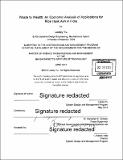| dc.contributor.advisor | Randolph E. Kirchain. | en_US |
| dc.contributor.author | Yu, Lesley (Lesley Tak Yan) | en_US |
| dc.contributor.other | Massachusetts Institute of Technology. Engineering Systems Division. | en_US |
| dc.date.accessioned | 2017-03-20T19:41:22Z | |
| dc.date.available | 2017-03-20T19:41:22Z | |
| dc.date.copyright | 2014 | en_US |
| dc.date.issued | 2014 | en_US |
| dc.identifier.uri | http://hdl.handle.net/1721.1/107587 | |
| dc.description | Thesis: S.M. in Engineering and Management, Massachusetts Institute of Technology, School of Engineering, System Design and Management Program, Engineering and Management Program, 2014. | en_US |
| dc.description | Cataloged from PDF version of thesis. | en_US |
| dc.description | Includes bibliographical references (pages 87-[90]). | en_US |
| dc.description.abstract | As the world's second largest rice grower, India can generate up to 5 million MT of ash from burning rice husk for fuel. The material that remains after combustion, known as Rice Husk Ash (RHA), is high in silica content, provides good insulation, and has a large surface areas for chemical reactions. These characteristics of RHA allow it to be used in a variety of applications such as insulation in steelmaking, substitute for raw material in the cement and brickmaking industry, water filtration, pest control, and the production of precipitated silica. While RHA is currently used in the steel industry in India, and to a smaller degree, in the cement industry, there are many waste-to-wealth opportunities to use RHA which are currently not being leveraged. This results in a loss of land for RHA disposal and more importantly, wasted opportunities to extract value from RHA. There has been a large amount of research conducted on using RHA. The publications around this research have typically been broad and qualitative, describing the potential applications of RHA on a high level, or focused on technical details pertaining to a specific set up using RHA. While the information currently available is extremely important, it is not easily leveraged by entrepreneurs who would be interested in increasing their use of RHA. There seems to be a lack of studies which compare the various applications for RHA qualitatively. The purpose of this thesis is to help current and potential RHA entrepreneurs to apply available research in making decisions about how to make use of RHA, by creating a framework to assess the applications of RHA economically. While this paper is focused on RHA, it is intended that the framework can be used in assessing opportunities to use other biomass ash material. | en_US |
| dc.description.statementofresponsibility | by Lesley Yu. | en_US |
| dc.format.extent | 89, 1 unnumbered pages | en_US |
| dc.language.iso | eng | en_US |
| dc.publisher | Massachusetts Institute of Technology | en_US |
| dc.rights | MIT theses are protected by copyright. They may be viewed, downloaded, or printed from this source but further reproduction or distribution in any format is prohibited without written permission. | en_US |
| dc.rights.uri | http://dspace.mit.edu/handle/1721.1/7582 | en_US |
| dc.subject | Engineering and Management Program. | en_US |
| dc.subject | System Design and Management Program. | en_US |
| dc.subject | Engineering Systems Division. | en_US |
| dc.title | Waste to wealth : an economic analysis of applications for Rice Husk Ash in India | en_US |
| dc.title.alternative | Economic analysis of applications for Rice Husk Ash in India | en_US |
| dc.type | Thesis | en_US |
| dc.description.degree | S.M. in Engineering and Management | en_US |
| dc.contributor.department | Massachusetts Institute of Technology. Engineering and Management Program | en_US |
| dc.contributor.department | System Design and Management Program. | en_US |
| dc.identifier.oclc | 974706129 | en_US |
